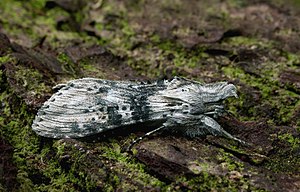Mugwort Monk
| Mugwort Monk | ||||||||||||
|---|---|---|---|---|---|---|---|---|---|---|---|---|

Mugwort monk ( Cucullia absinthii ) |
||||||||||||
| Systematics | ||||||||||||
|
||||||||||||
| Scientific name | ||||||||||||
| Cucullia absinthii | ||||||||||||
| ( Linnaeus , 1761) |
The mugwort Monk ( Cucullia absinthii , Syn. : Cucullia artemisiae ), and wormwood monk called, is a butterfly ( moth ) from the family of cutworms (Noctuidae).
features
butterfly
The moths reach a wingspan of about 35 to 44 millimeters. The forewings are narrow and have a pale gray to brownish gray basic color. Both the inner and the outer transverse line are indistinct. As a delimitation of the blurred flaws, clear black points can be seen, which can also lie within the flaw. The midfield is darkened. Wedge-shaped black spots stand out on the hem. The hind wings are whitish, changing to a gray tone on the outside. The back crest is clearly developed on the abdomen.
Caterpillar
Young caterpillars show a simple green and white striped pattern. In the adult animals, hump-like, greenish segments are characteristic, which are provided with large, crescent-shaped, reddish-brown drawing elements. The back, side back, and side lines are thin and white in color. The head is spotted yellow and brownish.
Doll
The pupa is predominantly yellowish in color, although the wing sheaths shimmer green. The cremaster is short and spatulate.
Similar species
While the moths can be easily distinguished from other monk species due to their distinctive drawing, the caterpillars can be confused with those of the silver monk ( Cucullia argenthea ), but are drawn with less contrast, especially because argenthea has some dark purple drawing elements .
Geographical occurrence and habitat
The species is distributed through almost all of Europe and is only absent in the very northern and very southern peripheral zones. Its eastern expansion includes Asia Minor , the Caucasus, the northern Iran and extends further to western Siberia, the Altai -Gebirge, the Tian Shan massif, here shown in the Ili region, on Issyk Kul (also Issyk-Kul, Kyrgyzstan) in Kyrgyz mountains , near Naryn (Kyrgyzstan) and near Scharkent (Kazakhstan) and in the Tarbagatai Mountains . In the Alps it rises to an altitude of 1,600 meters. The mugwort monk is mainly found on sandy soils, such as on dry slopes as well as on wastelands and rubble areas, where the main food plant of the caterpillars (wormwood) grows. Occasionally, caterpillars have also been found on wormwood planted in gardens.
Way of life
The species usually forms one generation per year, the moths of which fly from late May to early August. Axel Steiner, on the other hand, only states the flight time of the butterflies in Baden-Württemberg from the beginning of July to mid-August. The flighty moths are crepuscular and nocturnal and are only slightly attracted to artificial light sources . They suck nectar. The caterpillars feed mainly on common mugwort ( Artemisia vulgaris ), wormwood ( Artemisia absinthium ) and, to a lesser extent , field mugwort ( Artemisia campestris ). Younger caterpillars first feed on the flowers, later on the fruit heads. Due to their coloring, they are perfectly adapted to their environment and are thus largely protected from enemies. They pupate in the ground in autumn, with the pupae occasionally lying over two years.
Danger
The mugwort monk is rare in most of its areas of occurrence in Germany. He is on the red list of endangered species on the warning list.
Systematics and taxonomy
The species was established by Carl von Linné in 1761 as Phalaena Noctua absinthii . The type locality is Sweden. The species was also described under the name Phalaena Noctua punctigera by Johann Siegfried Hufnagel in 1766 and under the name Cucullia clausa by Francis Walker in 1857. Both names are thus more recent synonyms of Cucullia absinthii (Linné, 1761).
swell
Individual evidence
- ↑ a b Gábor Ronkay & László Ronkay: Cucullinae I . In: Michael Fibiger, Martin R. Honey, W. Gerald Tremevan (Eds.): Noctuidae Europaeae . tape 6 . Entomological Press, Sorø 1994, ISBN 87-89430-03-4 (English).
- ↑ a b c Walter Forster , Theodor A. Wohlfahrt : The butterflies of Central Europe. Volume 4: Owls. (Noctuidae). Franckh'sche Verlagshandlung, Stuttgart 1971, ISBN 3-440-03752-5 .
- ↑ a b c Günter Ebert (Ed.): The butterflies of Baden-Württemberg . 1st edition. tape 6 . Moth IV. Noctuidae 2nd part. Ulmer, Stuttgart (Hohenheim) 1997, ISBN 3-8001-3482-9 .
- ^ Gábor Ronkay and László Ronkay: The Witt Catalog. A Taxonomic Atlas of the Eurasian and North African Noctuoidea. volume II Cuculliinae I. 365 p., Heterocera Press, Budapest 2009 ISBN 978-963-88014-2-5
- ↑ Federal Agency for Nature Conservation (Ed.): Red List of Endangered Animals in Germany . Landwirtschaftsverlag, Münster 1998, ISBN 3-89624-110-9 .
literature
- Günter Ebert (Ed.): The butterflies of Baden-Württemberg . 1st edition. tape 6 . Moth IV. Noctuidae 2nd part. Ulmer, Stuttgart (Hohenheim) 1997, ISBN 3-8001-3482-9 .
- Gábor Ronkay & László Ronkay: Cucullinae I . In: Michael Fibiger, Martin R. Honey, W. Gerald Tremevan (Eds.): Noctuidae Europaeae . tape 6 . Entomological Press, Sorø 1994, ISBN 87-89430-03-4 (English).
- Gábor Ronkay and László Ronkay: The Witt Catalog. A Taxonomic Atlas of the Eurasian and North African Noctuoidea. volume II Cuculliinae I. 365 p., Heterocera Press, Budapest 2009 ISBN 978-963-88014-2-5
Web links
- Lepiforum e. V. Taxonomy and Photos
- www.schmetterlinge-deutschlands.de Endangerment
- Cucullia absinthii in Fauna Europaea

